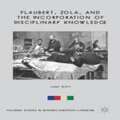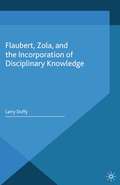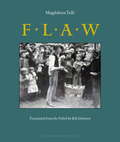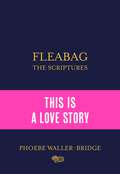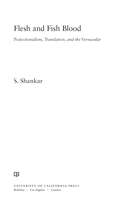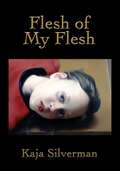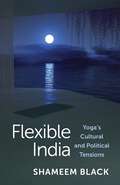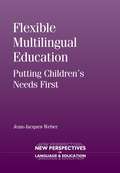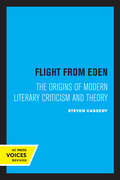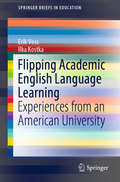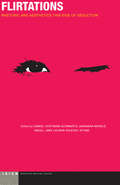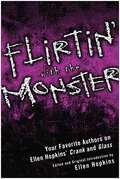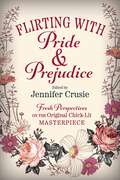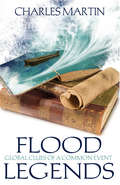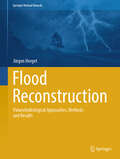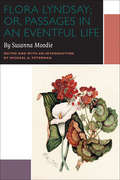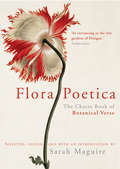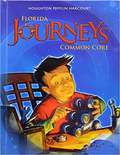- Table View
- List View
Flaubert, Zola, and the Incorporation of Disciplinary Knowledge
by Larry DuffyFlaubert, Zola and the Incorporation of Disciplinary Knowledge transcends traditional author studies to focus on institutional dimensions of professional practices and knowledge concerning the body in nineteenth-century France, and on their articulation by literary and other texts. It examines how institutional developments in medicine and pharmacy are 'incorporated' within literary texts, arguing that such incorporation reflects acute concern with the body, and with knowledge considered metaphorically as body. In its innovative focus on incorporation as metaphor, the book explores theoretical relationships between body and text, exploiting the rich metaphorical potential of the institutional, professional body, constituted by discourse and associated with bodies of disciplinary knowledge. The institutional body 'incorporates' itself; the literary text 'incorporates' knowledge precisely about the body's incorporation of substances and practices. Offering cultural history of certain medical, pharmaceutical and scientific discourses, this book problematizes the boundaries between literary and other forms of discourse, themselves analogical to boundaries between different fields of disciplinary knowledge.
Flaubert, Zola, and the Incorporation of Disciplinary Knowledge (Palgrave Studies in Modern European Literature)
by L. DuffyThis book is about how France's two major documentary authors of the nineteenth century – Gustave Flaubert and Émile Zola – incorporate medical knowledge about the body into their works, and in so doing exploit its metaphorical potential of the body to engage in critical reflection about the accumulation and reconfiguration of knowledge.
Flaw
by Bill Johnston Magdalena TulliA single streetcar line runs around the sleepy suburban square of an unnamed city. One day--out of nowhere--a group of hapless refugees pour from the streetcar and set up camp in the square. The residents grow hostile to the disruption and chaos, and eventually take matters into their own hands... Flaw is Tulli's most intense and personally motivated work to date, while still retaining the signature mind-and word-play so admired by critics and her growing readership.
Fleabag: The Sunday Times Bestseller (Nhb Modern Plays Ser.)
by Phoebe Waller-BridgeBestseller in the UK, Sunday Times, November 2019.The complete Fleabag. Every Word. Every Side-eye. Every Fox.Fleabag: The Scriptures includes new writing from Phoebe Waller-Bridge alongside the filming scripts and the never-before-seen stage directions from the Golden Globe, Emmy and BAFTA winning series. 'Perfect' Guardian'Perfect' Daily Telegraph'Perfect' Stylist 'Perfect' Independent'Perfect' Evening Standard 'Perfect' Metro'Perfect' Irish Times 'Perfect' RTE'Perfect' Spectator'Perfect' Refinery29'Perfect' Catholic Herald'Perfection' Financial Times***HAIRDRESSERNO.(pointing to Claire)That is EXACTLY what she asked for.FLEABAGNo it's not. We want compensation.HAIRDRESSERClaire?CLAIREI've got two important meetings and I look like a pencil.HAIRDRESSERNO. Don't blame me for your bad choices. Hair isn't everything.FLEABAGWow.HAIRDRESSERWhat?FLEABAGHair. Is. Everything. We wish it wasn't so we could actually think about something else occasionally. But it is. It's the difference between a good day and a bad day. We're meant to think that it is a symbol of power, a symbol of fertility, some people are exploited for it and it pays your fucking bills. Hair is everything, Anthony.
Flesh and Fish Blood
by Subramanian ShankarIn Flesh and Fish Blood Subramanian Shankar breaks new ground in postcolonial studies by exploring the rich potential of vernacular literary expressions. Shankar pushes beyond the postcolonial Anglophone canon and works with Indian literature and film in English, Tamil, and Hindi to present one of the first extended explorations of representations of caste, including a critical consideration of Tamil Dalit (so-called untouchable) literature. Shankar shows how these vernacular materials are often unexpectedly politically progressive and feminist, and provides insight on these oft-overlooked--but nonetheless sophisticated--South Asian cultural spaces. With its calls for renewed attention to translation issues and comparative methods in uncovering disregarded aspects of postcolonial societies, and provocative remarks on humanism and cosmopolitanism, Flesh and Fish Blood opens up new horizons of theoretical possibility for postcolonial studies and cultural analysis.
Flesh of My Flesh
by Kaja SilvermanSilverman (rhetoric and film studies, University of California, Berkeley) argues for a return to analogy, of seeing ourselves as part of a whole. She sees life as a conflict between the desire for unity and the need to be unique. While drawing from a number of sources, including Freud, Rilke, Proust, Leonardo Da Vinci and Nietzsche, her primal metaphors are from Ovid's Metamorphosis, especially the story of Orpheus and Eurydice. In the first half of the book, she concentrates on nineteenth century redactions of the myth. The ways in which artists and philosophers tackled the dichotomy is shown as entwined with a sense of selfhood but also a sense of mortality. In the second half, Silverman uses the examples of Malick's film The Thin Red Line, the "intervention" created by James Coleman for a 2002 Leonardo exhibit at the Louvre and, lastly, the photographs/paintings of Gerhardt Richter which include images and distortions of death. The book is illustrated throughout, along with a group of colored plates. Annotation c2010 Book News, Inc. , Portland, OR (booknews. com)
Flexible India: Yoga's Cultural and Political Tensions
by Shameem BlackYoga has offered the Indian state unprecedented opportunities for global, media-savvy political performance. Under Modi, it has promoted yoga tourism and staged mass yoga sessions, and Indian officials have proposed yoga as a national solution to a range of social problems, from reducing rape to curing cancer. But as yoga has gone global, its cultural meanings have spiraled far and wide. In Flexible India, Shameem Black travels into unexpected realms of popular culture in English from India, its diaspora, and the West to explore and critique yoga as an exercise in cultural power.Drawing on her own experience and her readings of political spectacles, yoga murder mysteries, court cases, art installations, and digital media, Black shows how yoga’s imaginative power supports diverse political and cultural ends. Although many cultural practices in today’s India exemplify “culture wars” between liberal and conservative agendas, Flexible India argues that visions of yoga offer a “culture peace” that conceals, without resolving, such tensions. This flexibility allows states, corporations, and individuals to think of themselves as welcoming and tolerant while still, in many cases, supporting practices that make minority populations increasingly vulnerable. However, as Black shows, yoga can also be imagined in ways that offer new tools for critiquing hierarchical structures of power and race, Hindu nationalism, cultural appropriation, and self-help capitalism.
Flexible Multilingual Education
by Jean-Jacques WeberThis book examines the benefits of multilingual education that puts children's needs and interests above the individual languages involved. It advocates flexible multilingual education, which builds upon children's actual home resources and provides access to both the local and global languages that students need for their educational and professional success. It argues that, as more and more children grow up multilingually in our globalised world, there is a need for more nuanced multilingual solutions in language-in-education policies. The case studies reveal that flexible multilingual education - rather than mother tongue education - is the most promising way of moving towards the elusive goal of educational equity in today's world of globalisation, migration and superdiversity.
Flight from Eden: The Origins of Modern Literary Criticism and Theory
by Steven CassedySteven Cassedy takes aim at two of the most enduring myths of modern criticism: that it is secular, and that it is new and autonomous. He argues that though modern criticism is often forbiddingly scientific and technical, the modern critic remains something of a mystic. Every school of modern criticism—from structuralism to postmodern criticism—rests on a faith in an "Eden," an irreducible essence, a myth, like the common myth that there is an intrinsic distinction between "poetic" language and "ordinary" language. The modern critic attempts to abandon all mystical faith; this is the "flight from Eden." But it is always in vain. It is traditionally assumed that modern literary criticism and theory came from France, and relatively recently. In fact, according to Cassedy, the entire modern critical consciousness was already formed by the early twentieth century in the minds of writers who were primarily neither professional critics nor philosophers, but poets. Some were French (Mallarmé, and Valéry); others were not (Rilke, Bely, and the Russian avant-garde poet Velimir Khlebnikov). In them we find the same Edenic faith, the same effort to abandon it, and the same failure of that effort. This title is part of UC Press's Voices Revived program, which commemorates University of California Press’s mission to seek out and cultivate the brightest minds and give them voice, reach, and impact. Drawing on a backlist dating to 1893, Voices Revived makes high-quality, peer-reviewed scholarship accessible once again using print-on-demand technology. This title was originally published in 1990.
Flipping Academic English Language Learning: Experiences from an American University (SpringerBriefs in Education)
by Erik Voss Ilka KostkaThis book draws on theory, research, and practice-oriented literature to offer an introduction to flipped learning and offer busy instructors advice on how to flip their academic English language courses. The chapters balance theoretical foundations, practical applications, and useful resources for developing materials. The first half of this book defines flipped learning and academic English, describes how it supports English language learning, and explains the role of technology, as well as issues with accountability and feedback. The second half of the book then makes connections between the theoretical issues presented in the first three chapters and the practical applications in the following chapters, which provide lesson descriptions and assessment ideas for language learning contexts with or without access to technology. The book concludes with a list of tools and technologies for developing materials and activities, as well as additional resources for professional development and further exploration of flipped English language learning.
Flirtations: Rhetoric and Aesthetics This Side of Seduction (Idiom: Inventing Writing Theory)
by Barbara Natalie Nagel Lauren Shizuko StoneWhat is flirtation, and how does it differ from seduction?In historical terms, the particular question of flirtation has tended to be obscured by that of seduction, which has understandably been a major preoccupation for twentieth-century thought and critical theory. Both the discourse and the critique of seduction are unified by their shared obsession with a very determinate end: power. In contrast, flirtation is the game in which no one seems to gain the upper hand and no one seems to surrender. The counter-concept of flirtation has thus stood quietly to the side, never quite achieving the same prominence as that of seduction. It is this elusive (and largely ignored) territory of playing for play’s sake that is the subject of this anthology.The essays in this volume address the under-theorized terrain of flirtation not as a subgenre of seduction but rather as a phenomenon in its own right. Drawing on the interdisciplinary history of scholarship on flirtation even as it re-approaches the question from a distinctly aesthetic and literary-theoretical point of view, the contributors to Flirtations thus give an account of the practice of flirtation and of the figure of the flirt, taking up the act’s relationship to issues of mimesis, poetic ambiguity, and aesthetic pleasure. The art of this poetic playfulness—often read or misread as flirtation’s “empty gesture”—becomes suddenly legible as the wielding of a particular and subtle form of nonteleological power.
Flirtin' With the Monster: Your Favorite Authors on Ellen Hopkins' Crank and Glass
by Ellen HopkinsWhere is the line between truth and fiction? Why do love and addiction so often go hand in hand? What does the real "Kristina" think about the way her story is told in Crank and Glass? Crank and Glass have always been more than just stories. Join their author Ellen Hopkins and a host of other writers as they delve deep into Kristina's story, from the straight truth on the physical effects of methamphetamine addiction to the psychological consequences of keeping secrets (and how Hopkins' books have encouraged so many teens to reveal theirs). With an essay by Ellen's real-life daughter (the basis for the character of "Kristina") that tells her version of the events that inspired the books—along with perspectives from "Scott," "Jake," and 10-year-old "Hunter," the baby from Crank—Flirtin' with the Monster is a compelling journey through the complexities of Hopkins' beloved bestselling works.
Flirting With Pride And Prejudice: Fresh Perspectives On The Original Chick Lit Masterpiece
by Jennifer Crusie and Glenn YeffethOne of fiction's most well-loved novels, this 19th-century classic continues to capture the hearts of contemporary readers with its notions of marriage, dating, and romance. Leading authors in the area of women's literature and romance contribute to this fresh collection of essays on everything from Lydia's scandalous marriage to George Wickham to the female-dominated Bennett household and the emphasis placed on courtship and marriage. Contributors include Jo Beverly, Alesia Holliday, Mercedes Lackey, Joyce Millman, and Jill Winters. This compilation is an excellent companion for both those new to Jane Austen and well-versed Austen-philes.
Flood Legends
by Charles MartinThe story of the Deluge - or the Global Flood of Noah - permeates nearly every culture in the world in some way, shape, or form. While details vary between the different cultures, the same basic elements, occur in all versions. In "Flood Legends" you will discover: Detailed analysis of myth, legend, and historical details that are clues for a common, global event Unique research from a comparative study supporting the biblical history Despite the striking similarities of these accounts, some mythologists have looked at the minor differences in the stories and declared: "This never happened!" There is another alternative - to accept that the different versions all refer to the same event - passed on from generation to generation, through various developing cultures. Through these legends, this epic event has remained woven into the tapestry of cultural history - sharing not just the story of survival, but the power of obedience, and the fulfillment of God's enduring promise.
Flood Reconstruction: Palaeohydrological Approaches, Methods and Results (Springer Natural Hazards)
by Jürgen HergetFloods are among the most common and consequential natural disasters on Earth, occurring in all natural areas at all times. Yet, they often surprise us with their unexpected magnitude and the damage they cause. Terms like century and millennium floods quickly become widespread, but what do we really know about the floods of the past? How can we truly classify events like the Mississippi flood of 1993, the Elbe flood of 2002, or the Pakistan flood of 2010? Have such floods occurred before, or are they unprecedented, perhaps even consequences of ongoing climate change? To answer these questions, we must look into the past. However, river level records are often limited in duration, rarely extending back more than a hundred years, and many regions lack any measured values at all. Nonetheless, floods have left their marks. These marks may exist in the form of historical records and descriptions, which vary in extent across different cultural contexts. In addition to historical records, natural indicators like deposited sediments or erosion traces provide valuable information about past flood levels. This is particularly important for prehistoric periods and for regions without dense settlements and related gauges. These investigations lead to further questions about maximum flood levels and the earliest recorded observations. This book addresses these questions by exploring the reconstruction of floods from both historical and prehistoric times. It explains and discusses methods and results for beginners with diverse backgrounds in disciplines such as earth sciences, hydrology, history, and engineering. Extensive and carefully selected reference lists offer access to additional information.
Flora Lyndsay; or, Passages in an Eventful Life: A Novel by Susanna Moodie (Canadian Literature Collection)
by Susanna MoodieFlora Lyndsay is Susanna Moodie’s prequel to Roughing it in the Bush and Life in the Clearings. Though Moodie fictionalizes herself in the context of this novel, Flora Lyndsay remains a close personalized record of her family’s experiences in planning their emigration and crossing the Atlantic. Despite the limited critical attention it receives, Flora Lyndsay reveals Moodie’s style, her sense of form, and her distinctive approach to writing female autobiography. This edition, complete with a wide corpus of endnotes, an extensive list of emendations, and a critical introduction, helps address this oversight and gives a closer look at the iconic phenomenon that is Susanna Moodie.
Flora Poetica: The Chatto Book of Botanical Verse
by Sarah MaguireThis beautiful anthology brings together over 250 poems about flowers, plants and trees from eight centuries of writing in English, creating a rich bouquet of intriguing juxtapositions. Fourteenth-century lyrics sit next to poems of the twenty-first century; celebrations of plants native to the English soil share the volume with more exotic plant poetry. There are thirty poems about roses, by poets as diverse as Shakespeare, Dorothy Parker and the South African, Seitlhamo Motsapi; but there are also sections devoted to more unusual plants such as the mandrake, the starapple and the tamarind. An ex-gardener, the celebrated poet Sarah Maguire brings her extensive horticultural knowledge to bear on all the poems, arranging them into botanical families, identifying the plants being written about and writing a fascinating introduction. Whether you are a poetry lover, a gardener, a botanist, or simply the purchaser of the occasional bunch of flowers, this unique anthology allows you to luxuriate amidst the world's flora.
Florence Macarthy: by Sydney Owenson (Chawton House Library: Women's Novels)
by Jenny McAuleyThis is the first modern scholarly edition of Florence Macarthy: An Irish Tale (1818). Owenson's seventh novel, it is the most sophisticated of her four 'national tales'. Owenson combined conventional romance plotlines with the political and social problems in Ireland, following the passing of the Act of Union in 1800.
Florida Collections (Grade #11)
by Holt McdougalA literature book that helps build juvenille reading skills
Florida Holt Elements of Literature, Third Course
by Kylene Beers Carol Jago Deborah ApplemanNIMAC-sourced textbook
Florida SRA Imagine It! Level 2, Book 1, Themes: Kindness, Let's Explore, Around the Town
by Carl Bereiter Andy Biemiller Joe Campione Steve Graham Karen Harris Jan Hirshberg Marlene Scardamalia Doug Fuchs Iva Carruthers Michael Pressley Marsha Roit Anne Mckeough Marcy Stein Gerald H. Treadway Jr. Lynn Fuchs Peter PannellNIMAC-sourced textbook
Florida SRA Imagine It! Level 2, Book 2, Themes: Look Again, Courage, America's People
by Sra Mcgraw-HillNIMAC-sourced textbook
Florida Treasures: Grade 1, Book 4
by Douglas Fisher Donald R. Bear Janice A. DoleA series of stories with reading comprehension and interactive exercises.
